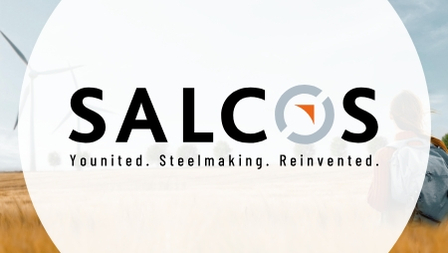Green steel production with hydrogen: Salzgitter AG and Sunfire continue lighthouse project
15.12.2023 | Salzgitter AG
Sunfire and Salzgitter AG are pushing ahead with the use of innovative SOEC electrolysis in industry to produce green hydrogen. They are working with the TU Bergakademie Freiberg to validate the latest stacks in the GrInHy3.0 research project.
Green hydrogen is playing a central role in decarbonizing the steel industry. High-temperature SOEC electrolyzers can produce this hydrogen highly efficiently and therefore cost effectively. Sunfire, Salzgitter AG and the TU Bergakademie Freiberg are now taking an important step together towards rolling out this technology at an industrial scale.
The partners in the GrInHy3.0 research project are integrating the latest SOEC stack technology from Sunfire into the into the hydrogen network of the Salzgitter Flachstahl GmbH steel mill. The facility will produce 16.5 kg of hydrogen per hour, which will be used in processes such as the direct reduction of iron ore at the µDral pilot plant.
The companies are continuing their partnership after completing several successful projects in their GrInHy ("Green Industrial Hydrogen") series. In the previous project, Sunfire’s SOEC electrolyzer achieved a record efficiency of 84%el,LHV.
Eight of the modules are now being replaced after clocking in over 19,000 operating hours and producing 190 metric tons of hydrogen. Two new test modules with an electrolysis output of 540 kW will be integrated into the existing infrastructure. They are expected to generate important information for the upcoming serial production. Commissioning is planned for 2024.
For Salzgitter AG, the project is an important step on the path to green steel production, which the Group is pursuing with initiatives such as its "SALCOS® – Salzgitter Low CO2 Steelmaking" program.
The TU Bergakademie Freiberg rounds out the project consortium. Researchers at the university’s Institute of Nonferrous Metallurgy and High-Purity Materials are looking at various aspects of sustainability and examining options which include recycling and reusing components. They are also doing research on the life cycle of the SOEC stacks.
The equipment is subjected to a great deal of stress, as the SOEC electrolyzers split water vapor into oxygen and hydrogen at a temperature of 850°C. As a result, Sunfire has upgraded its stacks, especially in terms of robustness. This means industrial users will be able to benefit from the systems’ extended service life.
The GrInHy3.0 research project will run until 2027 and is subsidized by the Federal Ministry for Economic Affairs and Climate Action.
Christian von Olshausen, CTO of Sunfire:
"Thanks to their unrivaled efficiency, high-temperature SOEC electrolyzers will be the preferred solution in many applications where waste heat is available. We have rendered our systems more efficient and robust in preparation for industrial serial production. Steelworks are the perfect environment to use SOEC electrolyzers, so it’s great that we are able to continue our long-standing partnership with Salzgitter AG and validate the new modules under real operating conditions."
Ralph Schaper, Head of Energy Management at Salzgitter Flachstahl GmbH:
"For a long time, our company has placed great emphasis on sustainable resource use, especially energy efficiency. GrInHy3.0 will be the next step forward in our successful GrInHy project series. High-temperature electrolysis uses waste heat from our production processes; it therefore requires comparatively little electricity and its market maturity is within reach. This has positively contributed to our SALCOS® transformation program. For this reason, I am very pleased that our fruitful collaboration with Sunfire is entering a third round to further advance this pioneering technology."
Prof. Dr.-Ing. Alexandros Charitos, Institute Director INEMET and Project Manager from the Technical University Bergakademie Freiberg (TUBAF) side:
"In this stage of the project, we are already looking at a long-term perspective on how we can minimize the environmental impact of the future waste stream generated by the production and consumption of hydrogen. At INEMET, the focus of our research is not only on developing the recycling strategy for the SOEC stack, but also on creating a simulation-based life cycle assessment of the entire HTC module in order to obtain a comprehensive overview of all required raw materials and mass flows in the system. The methodology applied will make it possible to define a closed-loop design to recycle the materials from the end-of-life (EoL) of the SOEC stack, thus creating compounds that can be reused in the new stack."

Contact Salzgitter AG:
Olaf Reinecke
Press Spokesperson
Telefon: +49 5341 21-5350
reinecke.o(at)salzgitter-ag.de
Contact Sunfire GmbH:
Laura Ziegler
Telefon: +49 160 959 953 44
laura.ziegler(at)sunfire.de







